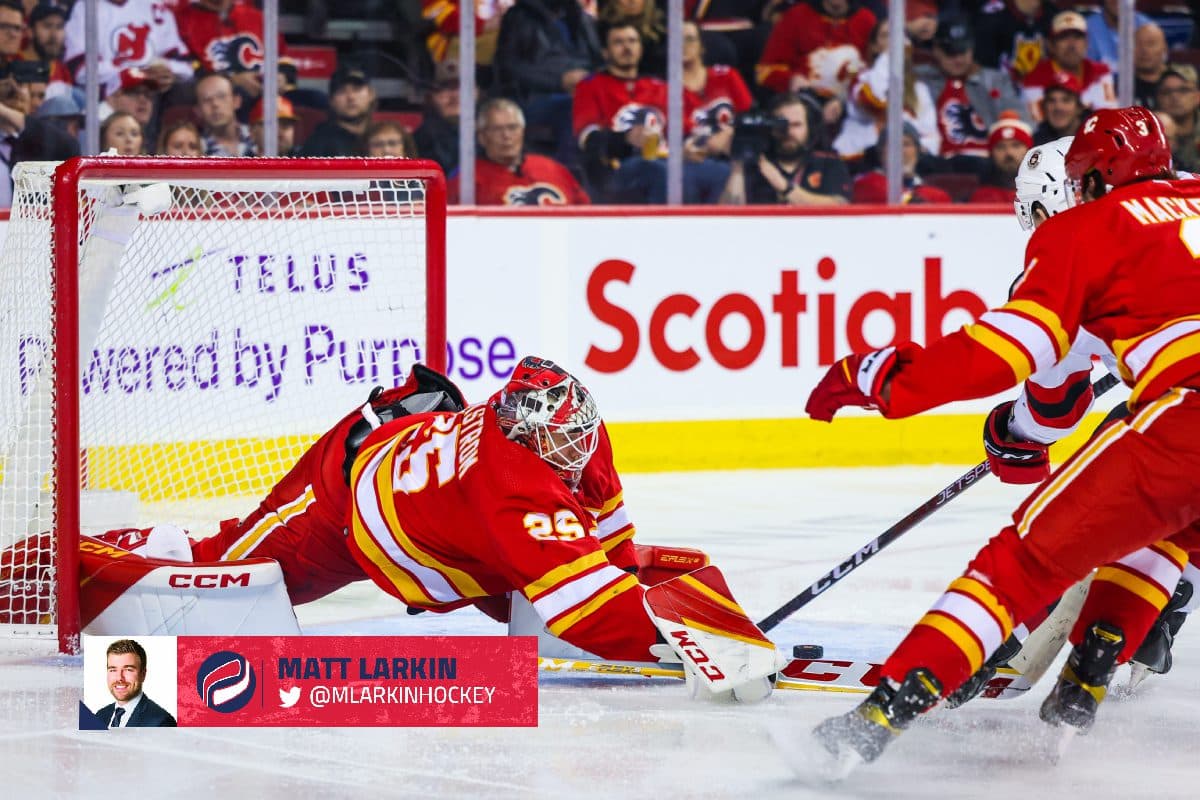What is the source of the Calgary Flames’ struggles?

It’s past time for the Calgary Flames and their fans to point fingers. But where?
Even when we factor in the epic offseason roster makeover, losing Johnny Gaudreau to free agency, trading Matthew Tkachuk, acquiring Jonathan Huberdeau, MacKenzie Weegar and Nazem Kadri…no one expected this start through 12 games. The Flames supposedly did a commendable job replacing their two 100-point scorers with high-impact players, right? They were still supposed to be one of the best teams in the Western Conference, right? They still had a lockdown defensive system under coach Darryl Sutter, one that theoretically got even better on paper with Weegar’s arrival.
Yet here they sit, losers of six consecutive games and seven of their past 10, with the same 5-5-2 record as the Chicago friggin’ Blackhawks. Not exactly how the Flames drew it up.
So what is the source of the problem so far? Let’s do some diligence and see if we can identify it.
Is it the injuries on defense?
Sutter has been vocal about the team’s desperate state on ‘D.’ They’re currently without Oliver Kylington, Christopher Tanev and Michael Stone, with only Tanev seemingly close to a return. The Flames still have Weegar, Rasmus Andersson, Noah Hanifin and Nikita Zadorov to anchor the blueline, though. If we look at the fallbacks: sure, the likes of Connor Mackey, Dennis Gilbert and Nick DeSimone are mostly replacement-level. But have they really been the problem? With Mackey on the ice at 5-on-5, the Flames have held an expected goal share of 43.64 percent, but the ice has tilted square in Calgary’s favor with Gilbert and DeSimone on the ice. Plus it’s not like any of them is doing the heavy lifting. They’re logging 10-12 minutes a night apiece.
Verdict: Not really.
Is it the goaltending?
Last season, Jacob Markstrom led the NHL in shutouts, was a second-team all-star and finished second in the Vezina Trophy vote. He imploded in the second round of the playoffs, however, and it appears that ugly stretch has carried over into the regular season. Backup Dan Vladar hasn’t been himself, either.
Here’s a glance at the differences in Markstrom year over year so far:
| (All strengths) | SV% | Rank | GSAA/60 | Rank |
| 2021-22 | .922 | 3rd | 0.42 | 5th |
| 2022-23 | .893 | 43rd | -0.34 | 43rd |
And now Vladar:
| (All strengths) | SV% | Rank | GSAA/60 | Rank |
| 2021-22 | .906 | 41st | -0.02 | 41st |
| 2022-23 | .865 | 63rd | -1.14 | 62nd |
Wow. So Markstrom was one of the league’s absolute elite last year and has performed at pretty much a middling backup level so far this season, while Vladar has performed at an AHL level. He’s allowing more than a full additional goal below average in his appearances so far (albeit in just a three-game sample). Goaltending has been an absolute disaster for the Flames when it was supposed to be a strength.
So we’ve established that Calgary’s goaltending has been terrible. But have Markstrom and Vladar also been hung out to dry more this season? For goaltenders, 5-on-5 expected goals against per 60 is one of the best stats to approximate the difficulty of one’s workload. Among 69 goalies who played at least 500 minutes at 5-on-5 last season, Markstrom and Vladar sat 60th and 54th, respectively, in xGA/60, meaning they had two of the easiest workloads in the league. They had excellent defensive play happening in front of them.
This season? Among 64 netminders who have logged at least 100 minutes at 5-on-5, they sit 39th and 57th. Markstrom’s degree of difficulty has gone up slightly, while Vladar’s is actually lower. They are both seeing roughly the same number of high-danger shots as they did last season. So the defensive play is not to blame for the netminders’ woes. They have simply just been B.A.D. at stopping pucks.
Verdict: Absolutely.
Is it the 5-on-5 team defense?
The goalie stats already give us a hint that Calgary’s defensive play hasn’t regressed, but let’s just double check to make sure we see no alarming trends year over year:
| (5-on-5) | CA/60 | SA/60 | SCA/60 | HDCA/60 | XGA/60 |
| 2021-22 | 50.61 (3rd) | 28.14 (5th) | 24.6 (3rd) | 9.59 (3rd) | 2.29 (3rd) |
| 2022-23 | 54.36 (9th) | 27.56 (6th) | 29.73 (20th) | 10.63 (7th) | 2.48 (10th) |
So the Flames actually have slipped a tiny bit. Being so depleted on defense likely contributes to that problem. They’re giving up far more scoring chances at 5-on-5. But overall? This is still a decidedly above-average defensive team, near the top of the league in most important metrics. As an aside: the penalty killing efficiency is down year over year but not an alarming amount.
Verdict: A little bit
Is it 5-on-5 team offense?
Even with Huberdeau and Kadri in town, the Flames still lost two of the biggest offensive weapons in the league in Gaudreau and Tkachuk. So is scoring or chance generation the problem?
Let’s compare year over year again.
| (5-on-5) | CF/60 | SF/60 | SCF/60 | HDCF/60 | XGF/60 | Sh% |
| 2021-22 | 63.34 (3rd) | 34.74 (3rd) | 31.17 (3rd) | 11.84 (11th) | 2.79 (5th) | 8.52 (14th) |
| 2022-23 | 64.88 (4th) | 36.35 (3rd) | 29.84 (17th) | 12.37 (14th) | 2.90 (8th) | 7.46 (24th) |
So the Flames, like every Sutter team, remain of the league’s best at peppering opponents with shot attempts and getting may of them through to the net. Their actual chances have dipped a fair amount, as has their shooting percentage. So there’s some bad puck luck at play but also possibly an effect of losing Gaudreau’s and Tkachuk’s high-end skill. The power play is fine, by the way, actually converting at a higher rate than last year’s.
Verdict: Not really
Is it the scoring depth?
The Flames had four players top 35 goals last season, so their top six was prolific, but they had 10 players score in double figures, including six with at least 16 goals. This season, they aren’t seeing the depth of the lineup contribute as much. Milan Lucic, Blake Coleman and Dillon Dube have combined for two goals in 12 games. Combine that with just two goals from Andrew Mangiapane and one from Huberdeau so far and it’s clear the Flames aren’t getting nearly as distributed scoring as they had last season.
Huberdeau has been a big disappointment so far – all his individual chance-generating metrics are at career-worst levels in 5-on-5 play – but losing him to an upper-body (or lower-body according to some conflicting reports) injury still hurts, as he’s too talented to underachieve for long. The Flames’ depth will be tested. Last night it was Adam Ruzicka getting a look on the top line with Elias Lindholm and Tyler Toffoli.
Verdict: Yes.
Conclusion
Overall, there are a few causes for concern here. Calgary’s goaltending has been legitimately terrible, its scoring depth seems weakened, and the injuries are piling up. The Flames are also struggling to find chemistry on their revamped roster, not generating enough chances off the rush. The passing woes are likely the reason why their scoring chances are down despite their shot attempts not being down.
But – most of the team identity remains intact. Under Sutter, the Flames still tilt the ice and generally rank among the better squads in the league at keeping the puck in the other team’s zone and out of their own zone. Theoretically, their goaltending should bounce back, their shooting percentage should normalize, and they’ll start winning again soon.
Are these Flames as strong as last year’s? Doesn’t look like it. But they aren’t as bad as this losing streak. They should remain a playoff contender.
Advanced stats courtesy of Natural Stat Trick
_____
POINTSBET IS LIVE IN ONTARIO. PLAY NOW!

Think you know sports? PointsBet Canada is live in Ontario!
Recently by Matt Larkin
- Early 2024 World Cup roster projection: USA
- With Mitchell Miller, the Boston Bruins have embarrassed themselves – and insulted our intelligence
- Is Toronto Maple Leafs captain John Tavares actually in decline?
- The NHL coaching market: Who’s available now, in the near future and in the long term?
- Early 2024 World Cup roster projection: Canada
More from Matt Larkin
- 10 staggering on-pace stats to track so far in 2025-26 NHL season
- Matt Larkin’s midseason fantasy hockey top 300 player rankings for 2025-26
- This Week in the NHL: Will Carter Hart get start against former team?
- If Canucks do the unthinkable and trade Quinn Hughes…what would be his ideal landing spot?
- 2026 Olympics: Imagining the (banned) Team Russia roster